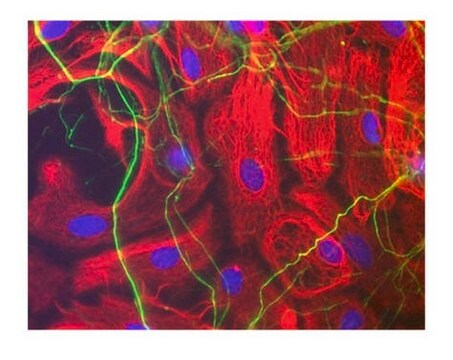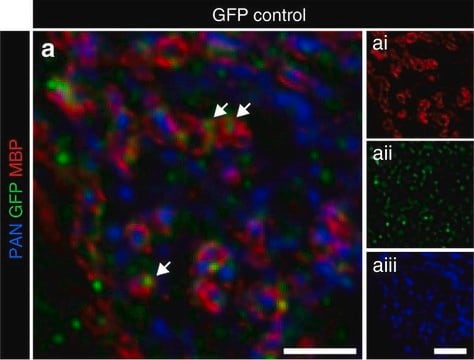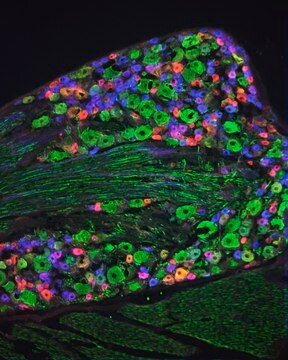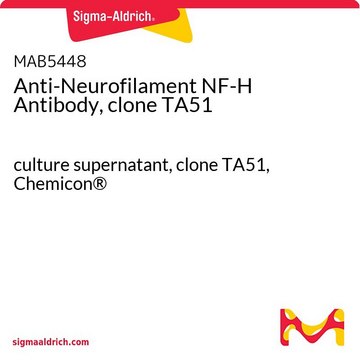MAB1592-C
Anti-Neurofilament NF-H Antibody, phosphorylated Antibody, clone NP1
clone NP1, from mouse
Synonim(y):
Neurofilament heavy polypeptide, NF-H, 200 kDa neurofilament protein, Neurofilament triplet H protein
About This Item
Polecane produkty
pochodzenie biologiczne
mouse
Poziom jakości
forma przeciwciała
purified antibody
rodzaj przeciwciała
primary antibodies
klon
NP1, monoclonal
reaktywność gatunkowa
canine, mouse, human, rat
reaktywność gatunkowa (przewidywana na podstawie homologii)
chicken (based on 100% sequence homology), bovine (based on 100% sequence homology), porcine (based on 100% sequence homology)
opakowanie
antibody small pack of 25 μg
metody
ELISA: suitable
immunohistochemistry: suitable (paraffin)
western blot: suitable
izotyp
IgG1κ
numer dostępu NCBI
numer dostępu UniProt
Warunki transportu
ambient
docelowa modyfikacja potranslacyjna
phosphorylation (not specified)
informacje o genach
bovine ... Nefh(528842)
chicken ... Nefh(417020)
dog ... Nefh(442940)
human ... NEFH(4744)
mouse ... Nefh(380684)
pig ... Nefh(100156492)
rat ... Nefh(24587)
Opis ogólny
Specyficzność
Immunogen
Zastosowanie
Immunohistochemistry Analysis: A representative lot detected Neurofilament NF-H in Immunohistochemistry applications (Benson, D.L., et. al. (1996). J Neurocytol. 25(3):181-96; Boylan, K., et. al. (2009). J Neurochem. 111(5):1182-91).
Western Blotting Analysis: A representative lot detected Neurofilament NF-H in Western Blotting applications (Benson, D.L., et. al. (1996). J Neurocytol. 25(3):181-96; Boylan, K., et. al. (2009). J Neurochem. 111(5):1182-91).
ELISA Analysis: A representative lot detected Neurofilament NF-H in ELISA applications (Boylan, K., et. al. (2009). J Neurochem. 111(5):1182-91; Toedebusch, C.M., et. al. (2017). J Vet Intem Med. 31(2):513-520; Mashita, T., et. al. (2015). J Vet Med Sci. 77(4):433-8).
Neuroscience
Jakość
Immunohistochemistry Analysis: A 1:50 dilution of this antibody detected Neurofilament NF-H in human cerebral cortex tissue.
Opis wartości docelowych
Postać fizyczna
Przechowywanie i stabilność
Handling Recommendations: Upon receipt and prior to removing the cap, centrifuge the vial and gently mix the solution. Aliquot into microcentrifuge tubes and store at -20°C. Avoid repeated freeze/thaw cycles, which may damage IgG and affect product performance.
Inne uwagi
Oświadczenie o zrzeczeniu się odpowiedzialności
Nie możesz znaleźć właściwego produktu?
Wypróbuj nasz Narzędzie selektora produktów.
Kod klasy składowania
12 - Non Combustible Liquids
Klasa zagrożenia wodnego (WGK)
WGK 2
Certyfikaty analizy (CoA)
Poszukaj Certyfikaty analizy (CoA), wpisując numer partii/serii produktów. Numery serii i partii można znaleźć na etykiecie produktu po słowach „seria” lub „partia”.
Masz już ten produkt?
Dokumenty związane z niedawno zakupionymi produktami zostały zamieszczone w Bibliotece dokumentów.
Nasz zespół naukowców ma doświadczenie we wszystkich obszarach badań, w tym w naukach przyrodniczych, materiałoznawstwie, syntezie chemicznej, chromatografii, analityce i wielu innych dziedzinach.
Skontaktuj się z zespołem ds. pomocy technicznej





